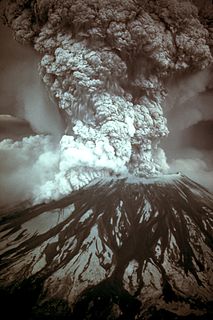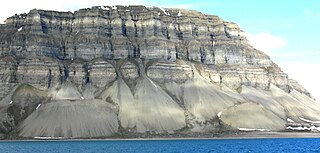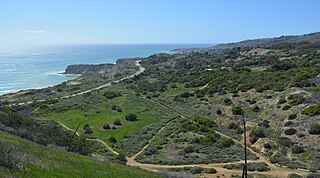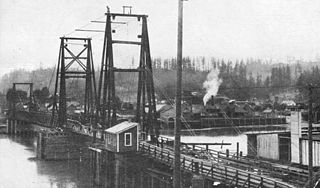
Cowlitz County is a county located in the U.S. state of Washington. As of the 2010 census, its population was 102,410. The county seat is Kelso, and its largest city is Longview. The county was formed in April 1854. Its name derives from the anglicized version of the Cowlitz Indian term, Cow-e-liske, meaning either "river of shifting sands" or "capturing the medicine spirit."

Longview is a city in Cowlitz County, Washington, United States. It is the principal city of the Longview, Washington Metropolitan Statistical Area, which encompasses all of Cowlitz County. Longview's population was 36,648 at the time of the 2010 census, making it the largest city in Cowlitz County. The city is located in southwestern Washington, at the junction of the Cowlitz and Columbia rivers. Longview shares a border with Kelso to the east, which is the county seat.

A megatsunami is a very large wave created by a large, sudden displacement of material into a body of water.

A slump is a form of mass wasting that occurs when a coherent mass of loosely consolidated materials or rock layers moves a short distance down a slope. Movement is characterized by sliding along a concave-upward or planar surface. Causes of slumping include earthquake shocks, thorough wetting, freezing and thawing, undercutting, and loading of a slope.

The Cowlitz River is a river in the state of Washington in the United States, a tributary of the Columbia River. Its tributaries drain a large region including the slopes of Mount Rainier, Mount Adams, and Mount St. Helens.

On May 18, 1980, a major volcanic eruption occurred at Mount St. Helens, a volcano located in Skamania County, in the U.S. state of Washington. The eruption was the most significant volcanic eruption to occur in the contiguous 48 U.S. states since the much smaller 1915 eruption of Lassen Peak in California. It has often been declared as the most disastrous volcanic eruption in U.S. history. The eruption was preceded by a two-month series of earthquakes and steam-venting episodes, caused by an injection of magma at shallow depth below the volcano that created a large bulge and a fracture system on the mountain's north slope.

Mass wasting, also known as slope movement or mass movement, is the geomorphic process by which soil, sand, regolith, and rock move downslope typically as a solid, continuous or discontinuous mass, largely under the force of gravity, but frequently with characteristics of a flow as in debris flows and mudflows. Types of mass wasting include creep, slides, flows, topples, and falls, each with its own characteristic features, and taking place over timescales from seconds to hundreds of years. Mass wasting occurs on both terrestrial and submarine slopes, and has been observed on Earth, Mars, Venus, and Jupiter's moon Io.

The Portuguese Bend region is the largest area of natural vegetation remaining on the Palos Verdes Peninsula, in Los Angeles County, California. Though once slated for development, the area is geologically unstable and is unsuitable for building.

A mudflow or mud flow is a form of mass wasting involving "very rapid to extremely rapid surging flow" of debris that has become partially or fully liquified by the addition of significant amounts of water to the source material.

Silver Star Mountain is an extinct volcano of the Cascade Range in the U.S. state of Washington. Consisting of late Eocene to Oligocene epoch rock, it lies within the Gifford Pinchot National Forest. Long inactive, the volcano sits over three lithologic units, including the large Silver Star Granodiorite unit.

The causes of landslides are usually related to instabilities in slopes. It is usually possible to identify one or more landslide causes and one landslide trigger. The difference between these two concepts is subtle but important. The landslide causes are the reasons that a landslide occurred in that location and at that time. Landslide causes are listed in the following table, and include geological factors, morphological factors, physical factors and factors associated with human activity.
The Swift Creek Landslide is an active, slow moving landslide located in western Washington, USA, due east of Everson on Sumas Mountain. Asbestos laden sediment originating from the landslide has recently generated much interest in this area. Asbestos is a known carcinogen. EPA sampling has documented asbestos in sediments in Swift Creek and in downstream Sumas River. Average asbestos levels in Swift Creek dredged material exceed the level that, in construction materials, triggers worker safety requirements and material handling and disposal regulations.
The Malpa landslide was one of the worst landslides in India. On 18 August 1998 at 3.00 a.m., massive landslides wiped away the entire village of Malpa in the Pithoragarh district of Uttarakhand, then in Uttar Pradesh in Kali Valley of Higher Kumaon division of the Himalayas. The rockfall started on 16 August bringing down huge rocks which initially killed three mules. A total of 221 people died, including 60 Hindu pilgrims traveling to Tibet as part of "Kailash Manas Sarovar Yatra". One noted death was that of the Indian dancer Protima Bedi. The rockfall continued till 21 August. As the area lies in a seismic zone, the earthquakes of 1979 and 1980 may have been the underlying cause, as was attributed by a report of the Wadia Institute of Himalayan Geology.

Greenleaf Peak is a mountain in the Cascade Range in the U.S. state of Washington, located on the north side of the Columbia River near Table Mountain, in the Columbia River Gorge. The peak lies within the Columbia River Gorge National Scenic Area near Bonneville Dam. It is 3,424 feet (1,044 m) in elevation. Botanist David Douglas climbed to the summit in September 1825, making this the first recorded mountain ascent in what is now Washington state.

On January 10, 2005, a major landslide occurred in the town of La Conchita, California. The landslide killed 10 people, and destroyed or damaged dozens of houses. The landslide occurred on part of a previous landslide that occurred in 1995. The historic slides are part of the larger Rincon Mountain slide, which "started many thousands of years ago and will continue generating slides in the future."

A major landslide occurred 4 miles (6.4 km) east of Oso, Washington, United States, on March 22, 2014, at 10:37 a.m. local time. A portion of an unstable hill collapsed, sending mud and debris to the south across the North Fork of the Stillaguamish River, engulfing a rural neighborhood, and covering an area of approximately 1 square mile (2.6 km2). Forty-three people were killed and 49 homes and other structures destroyed.

Allen Street Bridge was a bridge over the Cowlitz River between Kelso, Washington and Longview, Washington that collapsed on January 3, 1923.

The 2010 Mount Meager landslide was a large catastrophic debris avalanche that occurred in southwestern British Columbia, Canada, on August 6 at 3:27 a.m. PDT (UTC-7). Over 45,000,000 m3 (1.6×109 cu ft) of debris slid down Mount Meager, temporarily blocking Meager Creek and destroying local bridges, roads and equipment. It was one of the largest landslides in Canadian history and one of over 20 landslides to have occurred from the Mount Meager massif in the last 10,000 years.























